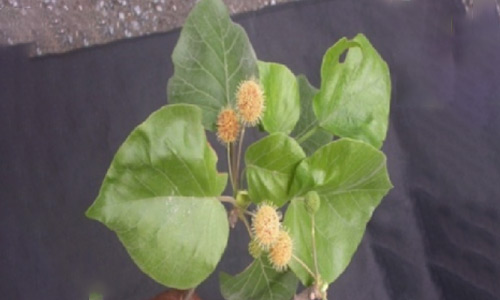|
Division
|
Angiosperms |
|
Class
|
Dicotledons |
|
Subclass |
Gamopetalae |
|
Series |
Epigynae |
|
Order |
Rubiales |
|
Family
|
Rubiaceae |
|
Genus
|
Adina |
|
Species
|
cordifolia |

|
Etymology: |
Derivied from Greek word adinos, clustered; referring to the arrangement of flowers in clusters. |
|
Botanical name
|
Adina cordifolia(Roxb.)Hook.f.(Haldina cordifolia(Roxb.) Ridsdale) |
|
Local/Trade names:
|
Haldu |
|
Conservation status:
|
Wild throughout north India. |
|
Digonestic features: |
Wood yellow when fresh cut. |
|
Description: |
Large deciduous tree; trunk buttressed at base. Bark lightgrey, exfoliates in patches. Leaves 8-20 cm long, broadly ovate or orbicular-cordate, abruptly acuminated, coriaceous,pubescent beneath; petiole 3-12 cm long, stipules conceals the terminal bud. Flowers small, yellow in globose pedunculate heads. Fruit capsule, many seeded, winged. |
|
Phenology: |
Fls.: June-August. Frts.: February-May. |
|
Distribution:
|
Throughout the India. |
|
Where to see it: |
Ornamental Flowering Section, Arboretum near Japanese Garden Gate No. 2. |
|
Uses: |
Timber is easy to saw, seasons well and takes good polish; durable under cover, resistant against subterranean termites, but highly susceptible to drywood termites. It is one of the best Indian woods for flooring and paneling railway carriages, and for bobbins. A good turnery wood. Haldu is accepted as grade I commercial and moisture-proof plywood timber. Wrapping, writing, and printing paper is manufactured from the wood pulp. Bark yields tannin; spent bark used for boards. Leaves used as fodder. Bark febrifuge. |
Chief Conservator of Forests & Chief Wildlife Warden is the Head of the Department. There is one post of Conservator of Forests & two posts of Deputy Conservator of Forests viz.